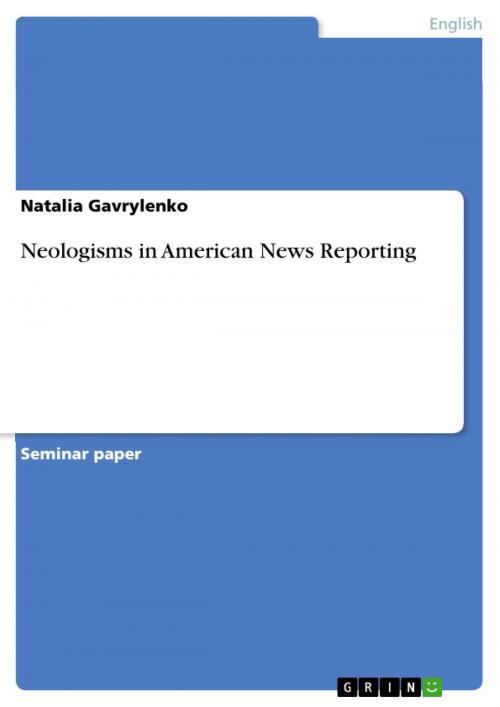| Author: | Natalia Gavrylenko | ISBN: | 9783638562416 |
| Publisher: | GRIN Publishing | Publication: | October 29, 2006 |
| Imprint: | GRIN Publishing | Language: | English |
| Author: | Natalia Gavrylenko |
| ISBN: | 9783638562416 |
| Publisher: | GRIN Publishing |
| Publication: | October 29, 2006 |
| Imprint: | GRIN Publishing |
| Language: | English |
Seminar paper from the year 2005 in the subject American Studies - Linguistics, grade: 2,4, Johannes Gutenberg University Mainz, 6 entries in the bibliography, language: English, abstract: Every nation is known by the culture represented through the language it keeps, and every aspect of the life of a people is reflected in their vocabulary. Like the history of a country, its vocabulary bears witness of its past and present. As the community changes in its technological development or social transformation, so does its language. Some words get out of usage or get transformed; new words are created to represent the reality brought to us by mass media in particular through news reporting. Although there are general patterns of word-formation, language is not a fixed, rigid system; according to the current stage of development new words enter the vocabulary continuously, and certain tendencies of forming new words appear and may disappear again. This work will be focused on current trends in American English word-formation and new words in news reporting. After the presentation of general definitions of neologisms, their aspects and major word-formation patterns, morphological classification will be shown. Although various semantic fields of neologisms will be introduced, it is almost impossible to present all tendencies. In order to fix certain trends, largely have been chosen and examined examples from John Algeo'sFifty Years Among the New Words ( A Dictionary of Neologisms, 1941 - 1991)and Jonathon Green's Neologisms - New Words since 1960.
Seminar paper from the year 2005 in the subject American Studies - Linguistics, grade: 2,4, Johannes Gutenberg University Mainz, 6 entries in the bibliography, language: English, abstract: Every nation is known by the culture represented through the language it keeps, and every aspect of the life of a people is reflected in their vocabulary. Like the history of a country, its vocabulary bears witness of its past and present. As the community changes in its technological development or social transformation, so does its language. Some words get out of usage or get transformed; new words are created to represent the reality brought to us by mass media in particular through news reporting. Although there are general patterns of word-formation, language is not a fixed, rigid system; according to the current stage of development new words enter the vocabulary continuously, and certain tendencies of forming new words appear and may disappear again. This work will be focused on current trends in American English word-formation and new words in news reporting. After the presentation of general definitions of neologisms, their aspects and major word-formation patterns, morphological classification will be shown. Although various semantic fields of neologisms will be introduced, it is almost impossible to present all tendencies. In order to fix certain trends, largely have been chosen and examined examples from John Algeo'sFifty Years Among the New Words ( A Dictionary of Neologisms, 1941 - 1991)and Jonathon Green's Neologisms - New Words since 1960.















